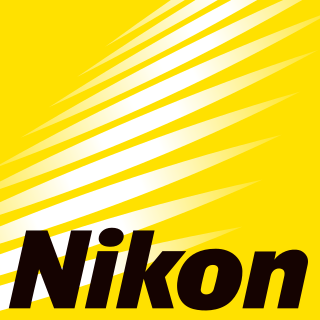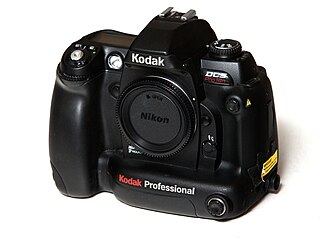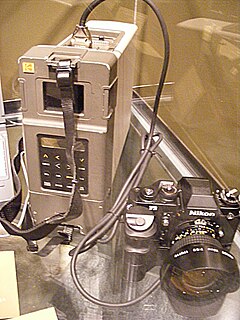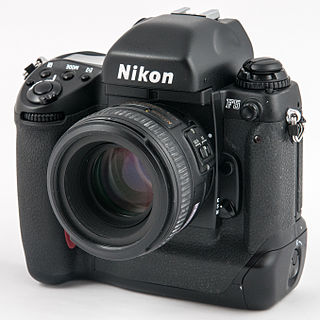What Was The First Camera Produced By Kodak?
Kodak DCS
Final updated.jpg)
The Kodak Digital Camera System is a series of digital single-lens reflex cameras and digital photographic camera backs that were released by Kodak in the 1990s and 2000s, and discontinued in 2005. They are all based on existing 35mm motion-picture show SLRs from Nikon, Canon and Sigma. The range includes the original Kodak DCS, the showtime commercially available digital SLR.
- History
- Models
- 35mm Nikon based
- APS Nikon based
- 35mm Canon based
- Medium format camera backs
- References
- External links
History

In 1975 Kodak engineer Steven Sasson invented the starting time digital nevertheless camera, which uses a Fairchild 100 x 100 pixel CCD. [i] [two] By 1986 Kodak had developed a sensor with i.4 one thousand thousand pixels. [iii]
A number of other inventions were fabricated to increase usability, including improvements in sensor engineering, the kickoff raw image format DCR, [ description needed ] and usable host software. The original Kodak DCS was launched in 1991, and is based on a stock Nikon F3 SLR with digital components. It uses a i.3-megapixel Kodak KAF-1300 sensor, and a separate shoulder-mounted processing and storage unit of measurement. The DCS 200 series of 1992 condenses the storage unit into a module which mounted onto the base of operations and back of a stock Nikon F-801s SLR. The module contains a built-in 80 megabyte hard drive and is powered with AA batteries. It was followed by the upgraded DCS 400 series of 1994, which replaces the difficult drive with a PCMCIA card slot. The DCS 400 serial includes the 1.5-megapixel DCS 420, and the 6-megapixel Kodak DCS 460, which retailed for $28,000 on launch. [four] In common with Kodak's later on 6-megapixel models, the DCS 460 used the award-winning APS-H Kodak M6 sensor. [5] A modified version of the DCS 420 was also sold past the Associated Press as the Associated Press NC2000. [6] In parallel with the DCS 400 series Kodak also sold the coordinating Kodak EOS DCS range, which was based on the Canon EOS-1N SLR. With the exception of the original DCS 100, these early models do not include LCD preview screens.
Kodak's subsequent models integrate the digital module with the camera torso more thoroughly, and include LCD preview screens and removable batteries. The DCS 500 series of 1998 is also based on the Canon EOS-1N, and comprises the 2-megapixel DCS 520 and the 6-megapixel DCS 560, which initially had a suggested retail cost of $28,500. [seven] These models were also sold by Catechism, as the Canon D2000 and D6000 respectively, and were the first digital SLRs sold under the Canon name. Kodak used the aforementioned electronics parcel for the DCS 600 serial, which is based on the Nikon F5. The DCS 600 range includes the Kodak DCS 620x, a high-sensitivity model with an upgraded indium tin oxide sensor and a cyan-magenta-yellow Bayer filter, which has a then-unique top ISO setting of ISO 6400.
Kodak concluded the initial DCS range with the DCS 700 serial, which comprises the 2-megapixel DCS 720x, the half dozen-megapixel DCS 760, and the half dozen-megapixel DCS 760m, which has a monochrome sensor. By the fourth dimension of launch, Kodak faced competition from the popular Nikon D1 and Nikon D1x, [8] which were physically smaller and cheaper. The DCS 760's initial listing price was $eight,000.
Kodak final generation of DCS cameras was launched with the Kodak DCS Pro 14n, a 14-megapixel total-frame digital SLR, in 2002, and continued with the upgraded DCS PRO SLR/due north in 2004. These two cameras are based on a Nikon F80 body, and are considerably more compact than previous Kodaks. They use sensors designed by Belgian imaging company FillFactory. The DCS PRO SLR/n was also accompanied by the Canon-compatible DCS PRO SLR/c, which is based on a Sigma SA9 SLR. Kodak discontinued the SLR/n and SLR/c in May 2005, [9] to concentrate on meaty digital cameras and high-finish medium format digital backs for Leaf, amidst others.
Kodak continued to design and manufacture digital imaging sensors, including the full-frame 18-megapixel KAF-18500, which is used in the Leica M9 digital rangefinder, until its digital sensor division was sold to Platinum Equity in 2012. This digital sensor company at present operates under the proper noun Trusense. [ten]
Models
35mm Nikon based

All models based on Nikon body and use Nikon's F mount.
- Kodak DCS - May 1991, later chosen DCS 100, commencement commercially bachelor DSLR camera, Nikon F3 based trunk. Many variants.
- Kodak DCS 200 - 1993, Nikon F-801s (N8008s) based body. Colour, monochrome and infrared variants.
- Kodak NC2000 series - Baronial 1994, Nikon F90/N90 and N90s based body, designed in speed and noise characteristics for printing use.
- Kodak DCS 400 serial - August 1994, Nikon F90/N90 and Nikon F90s/N90s based trunk
- Kodak DCS 600 series - 1999, Nikon F5 based body
- Kodak DCS 700 series - 2001, Nikon F5 based body
- Kodak DCS Pro 14n - 2002, Nikon F80 based body, full-frame. Kodak DCS Pro 14nx variant incorporates updated sensor, retention buffer and firmware from DCS Pro SLR/northward.
- Kodak DCS Pro SLR/due north - 2004, Nikon F80 based body, full-frame.

APS Nikon based
- Kodak DCS 300 series - 1998 and 1999, budget priced professional Nikon APS format SLR Pronea 600i and Pronea 6i based body, uses Nikon's F mount and additionally special Nikkor Ix (APS) lenses
35mm Canon based
All models use Catechism's EF lens mount.
- Kodak EOS DCS series - 1995, Canon EOS-1n based trunk. Rebranded by Catechism equally EOS DCS 1, -3 and -v.
- Kodak DCS 500 series - 1998, Canon EOS-1n based body. Rebranded by Canon as Catechism EOS D2000 and Canon EOS D6000
- Kodak DCS Pro SLR/c - 2004, Sigma SA9, with Canon EF compatible mount and electronics.

Medium format photographic camera backs
- Kodak DCS Pro 645 - 1995, 6-megapixel digital camera dorsum for several medium format cameras like Hasselblad 500 / 503, Mamiya RB / RZ and Sinar cameras
- Kodak DCS Pro Back / Plus / 645 - 2000, 16-megapixel digital camera back for several medium format cameras.
Related Research Articles

Canon EOS is an autofocus single-lens reflex camera (SLR) and mirrorless camera series produced by Catechism Inc. Introduced in 1987 with the Canon EOS 650, all EOS cameras used 35 mm motion-picture show until October 1996 when the EOS IX was released using the new and short-lived APS film. In 2000, the D30 was announced, equally the first digital SLR designed and produced entirely by Catechism. Since 2005, all newly appear EOS cameras have used digital image sensors rather than flick. The EOS line is nevertheless in production as Catechism'southward current digital SLR (DSLR) range, and, with the 2012 introduction of the Canon EOS Grand, Canon's mirrorless interchangeable-lens photographic camera (MILC) system. In 2018 the organization was farther extended with the introduction of the EOS R camera, Catechism's first full frame mirrorless interchangeable lens system.

Nikon Corporation , also known just as Nikon, is a Japanese multinational corporation headquartered in Tokyo, Nippon, specializing in optics and imaging products. The companies held past Nikon form the Nikon Group.

A digital single-lens reflex camera is a digital photographic camera that combines the eyes and the mechanisms of a single-lens reflex camera with a digital imaging sensor.
The Kodak Professional DCS Pro SLR/n is a 13.5 megapixel full-frame 35mm digital SLR produced as a collaboration betwixt Nikon Corporation and Eastman Kodak. It was an improved version of the Kodak Professional person DCS Pro 14n series, and was based on a modified Nikon N80 film SLR and thus uniform with almost all Nikon F mount lenses. The camera was announced in early 2004 and became available to purchase mid-year. A monochrome variant named Kodak Professional DCS Pro SLR/n thousand of the camera existed also.

Advanced Photo System type-C (APS-C) is an image sensor format approximately equivalent in size to the Avant-garde Photo System film negative in its C ("Classic") format, of 25.1×16.7 mm, an aspect ratio of iii:ii. Information technology is therefore also equivalent in size to the Super 35 motion picture picture format, which has the dimensions of 24.89 mm × 18.66 mm.

The Kodak Professional DCS Pro SLR/c is a 13.5 megapixel digital SLR photographic camera produced by Eastman Kodak. It is full frame—information technology uses an prototype sensor that is the full size of a 35 mm frame. It is compatible with Canon EOS lenses. The camera was launched on March 18, 2004 and incorporates the internal systems of the previous Nikon-compatible SLR/n in a Sigma SA9 SLR body.

The Nikon D1 is a digital single-lens reflex camera (DSLR) made past Nikon Corporation introduced on June 15, 1999. It featured a two.vii-megapixel image sensor, 4.5-frames-per-second continuous shooting, and accepted the full range of Nikon F-mount lenses. The camera body strongly resembled the F5 and had the aforementioned general layout of controls, allowing users of Nikon film SLR cameras to rapidly become proficient in using the camera. Autofocus speed on the D1 series bodies is extremely fast, even with "spiral-driven" AF lenses.

The Kodak Professional DCS Pro 14n is a professional Nikon F80 based F-mount digital SLR produced by Eastman Kodak. It was announced at the photographic merchandise show photokina in Germany during September 2002; product examples became bachelor in May 2003.

The Kodak DCS 300 series comprised 2 cameras, the DCS 315 and DCS 330. They were professional-level digital SLR cameras congenital by Eastman Kodak's Kodak Professional Imaging Solutions division. They were based on the Nikon Pronea 6i APS SLR camera and were aimed at a lower price signal than other models in the Kodak DCS range. The 1.5 megapixel DCS 315 was launched in 1998, while the 3 megapixel DCS 330 was launched in 1999. The DCS 315 was the first digital SLR camera to incorporate an image preview LCD and inbuilt JPEG processing.
The Contax N Digital was a six-megapixel digital SLR camera produced by Contax in Japan. The camera was announced in late 2000, and began to be sold in spring 2002, after several delays. The photographic camera received mixed reviews from the press, and was withdrawn from the market within a yr of its introduction.

A total-frame DSLR is a digital single-lens reflex camera (DSLR) with a 35 mm image sensor format. Historically, 35 mm was considered a small picture format compared with medium format, big format and even larger.

The Kodak Professional Digital Camera Organization or DCS, afterwards unofficially named DCS 100, was the kickoff commercially available digital single-lens reflex (DSLR) camera. Information technology was a customized camera back bearing the digital image sensor, mounted on a Nikon F3 body and released by Kodak in May 1991; the visitor had previously shown the camera at Photokina in 1990. Aimed at the photo journalism marketplace in society to improve the speed with which photographs could exist transmitted back to the studio or newsroom, the DCS had a resolution of 1.3 megapixels. The DCS 100 was publicly presented for the commencement fourth dimension in Arles (France), at the Journées de 50'Epitome Pro by Mr Ray H. DeMoulin, the worldwide President of the Eastman Kodak Company. 453 international journalists attended this presentation, which took identify in the Palais des Congres of Arles.

The Canon EOS D30 is a discontinued 3.ane-megapixel professional digital single lens reflex camera (DSLR) body, initially appear by Canon on May 17, 2000. Information technology is part of the Catechism EOS line of cameras and uses the EF lens mount. The EOS D30 was Canon's first "abode grown" digital SLR. Before that bespeak Catechism had a contract with Kodak to rebrand the Kodak two-megapixel DCS 520 as Canon EOS D2000 and the 6-megapixel DCS 560 as Canon EOS D6000 digital SLRs, which combined Kodak digital backs and Canon camera bodies.

The Kodak DCS 400 series was a series of Nikon based digital SLR cameras with sensor and added electronics produced by Eastman Kodak. It was part of Kodak'southward DCS line.

The Nikon F5 is a 35 mm moving picture-based single-lens reflex photographic camera torso manufactured by Nikon from 1996 through 2004. Information technology was the fifth in Nikon'due south professional person picture camera line, which began in 1959 with the Nikon F. Information technology followed the Nikon F4 of 1988, which had introduced in-body autofocus to Nikon'southward professional line. The F5 was in turn succeeded by the Nikon F6, also as Nikon's parallel range of professional person digital SLRs, beginning with the Nikon D1.

The EOS-1N is a 35mm single lens reflex (SLR) camera body produced by Canon. It was announced by Canon in 1994, and was the professional model in the range, superseding the original EOS-ane. The camera was itself superseded by the EOS-1v in 2000.

The Canon EOS D2000 was a 2-megapixel digital single-lens reflex camera developed past Kodak on a Canon EOS-1N trunk. It was released in March 1998. It features a CCD sensor and can shoot at 3.5 frames per second. Many enthusiasts regard the D2000 as Canon'due south first truly usable Digital SLR. It was released in tandem with the Catechism EOS D6000, a six-megapixel model.

The Canon EOS DCS iii was Kodak's second Canon based Digital SLR camera released in July 1995, four months after Kodak EOS-DCS 5. It uses a modified Canon EOS-1N motion picture camera with a modified Kodak NC2000e digital photographic camera back attached. Every bit a consequence, it maintained the Canon EF lens mountain, and full compatibility with all of Catechism'due south EF lenses made until that time. The camera was followed by the six megapixel Canon EOS DCS i, which was released afterward in Dec 1995.
The Canon EOS DCS 1 was Kodak'south tertiary Canon-based Digital SLR photographic camera. It was released in December 1995, following the cheaper EOS DCS 3, which was released earlier that year. Like that camera, information technology combined an EOS-1N body with a modified Kodak DCS 460 digital back. Despite offering a then-enormous resolution of six megapixels with a relatively large APS-H sensor, a number of technical issues meant that information technology was never a very popular camera other than for a few people with specialized roles.
References
- ↑ How Kodak invented the digital camera in 1975 Archived 2012-01-x at the Wayback Machine
- ↑ Carter, Rodger. "1970s". world wide web.digicamhistory.com . Retrieved 2018-05-11 .
- ↑ "What Is the History of the Digital Camera?". ThoughtCo . Retrieved 2018-05-eleven .
- ↑ Holusha, John (1995-07-ten). "Kodak Sees a Time to come Where Film Is Optional". The New York Times . Retrieved 2018-05-11 .
- ↑ Business Wire, October 1995, Kodak Imaging Sensor wins award from Technical Image Printing Association
- ↑ Eamon Hickey, Jan 2005, "A look back at the NC2000" Archived 2009-10-xiv at the Wayback Machine
- ↑ Business Wire, September 1998, Kodak Professional person Extends Portfolio of Digital Cameras
- ↑ "Kodak DCS 760 Review". DPReview. 2001-07-xvi. Retrieved 2018-05-11 .
- ↑ Kodak.com, May 2005, Notice OF DISCONTINUANCE
- ↑ "Kodak's epitome-sensor spin-off gets a name: Truesense". CNET. 2012-02-08. Retrieved 2018-05-eleven .
- ↑ Sand Dunes in Har Nuur (Black Lake), Western Mongolia October sixteen, 2006
External links
- The DCS Story: 17 years of Kodak Professional person digital camera systems Nikonweb
- KODAK PROFESSIONAL DCS Digital Cameras Kodak
- Kodak DCS cameras based on Nikon
- Nikon Digital Nonetheless SLR photographic camera models Mir
- DCS-1, iii, 5 Series with Canon EOS 1n body chassis Mir
- DCS-500 Serial with Canon EOS-1n body Chassis Mir
- The Kodak DCS420, DCS460, EOS DCS5 and Nikon E2s digital cameras on test Epi-centre
- Electronic Photo Imaging EPIcentre Library of Reports and Reviews
- Kodak DSLR Camera-wiki.org
This page is based on this Wikipedia article
Text is available under the CC By-SA 4.0 license; additional terms may apply.
Images, videos and audio are available nether their respective licenses.
Source: https://WikiMili.com/en/Kodak_DCS
Posted by: bivonasagen1999.blogspot.com


0 Response to "What Was The First Camera Produced By Kodak?"
Post a Comment